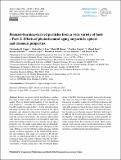Biomass-burning-derived particles from a wide variety of fuels – Part 2: Effects of photochemical aging on particle optical and chemical properties
Author(s)
Cappa, Christopher D; Lim, Christopher Y; Hagan, David H; Coggon, Matthew; Koss, Abigail; Sekimoto, Kanako; de Gouw, Joost; Onasch, Timothy B; Warneke, Carsten; Kroll, Jesse H; ... Show more Show less
DownloadPublished version (3.623Mb)
Publisher with Creative Commons License
Publisher with Creative Commons License
Creative Commons Attribution
Terms of use
Metadata
Show full item recordAbstract
Particles in smoke emitted from biomass combustion have a large impact on global climate and urban air quality. There is limited understanding of how particle optical properties-especially the contributions of black carbon (BC) and brown carbon (BrC)-evolve with photochemical aging of smoke. We analyze the evolution of the optical properties and chemical composition of particles produced from combustion of a wide variety of biomass fuels, largely from the western United States. The smoke is photochemically aged in a reaction chamber over atmospheric-equivalent timescales ranging from 0.25 to 8 d. Various aerosol optical properties (e.g., the single-scatter albedo, the wavelength dependence of absorption, and the BC mass absorption coefficient, MACBC) evolved with photochemical aging, with the specific evolution dependent on the initial particle properties and conditions. The impact of coatings on BC absorption (the so-called lensing effect) was small, even after photochemical aging. The initial evolution of the BrC absorptivity (MACBrC) varied between individual burns but decreased consistently at longer aging times; the wavelength dependence of the BrC absorption generally increased with aging. The observed changes to BrC properties result from a combination of secondary organic aerosol (SOA) production and heterogeneous oxidation of primary and secondary OA mass, with SOA production being the major driver of the changes. The SOA properties varied with time, reflecting both formation from precursors having a range of lifetimes with respect to OH and the evolving photochemical environment within the chamber. Although the absorptivity of BrC generally decreases with aging, the dilution-corrected absorption may actually increase from the production of SOA. These experimental results provide context for the interpretation of ambient observations of the evolution of particle optical properties in biomass-combustion-derived smoke plumes.
Date issued
2020-07Department
Massachusetts Institute of Technology. Department of Civil and Environmental EngineeringJournal
Atmospheric Chemistry and Physics
Publisher
Copernicus GmbH
Citation
Cappa, C. D., Lim, C. Y., Hagan, D. H., Coggon, M., Koss, A., Sekimoto, K., de Gouw, J., Onasch, T. B., Warneke, C., and Kroll, J. H.: Biomass-burning-derived particles from a wide variety of fuels – Part 2: Effects of photochemical aging on particle optical and chemical properties, Atmos. Chem. Phys., 20, 8511–8532, 2020
Version: Final published version
ISSN
1680-7324
1680-7316